1—
The New Element Modifies the Elements around It
Hyatt Hotel and Federal Plaza
Even before the Grand Avenue was built, it began to have side effects. Agreements to erect a new hotel and a federal office building nearby were obtained from third parties, along with support for these efforts from the city. Thus the catalyst begins to structure a receptive environment even before it takes physical shape. Although it might appear that the hotel and federal building caused the Grand Avenue, the opposite is closer to the truth.
Skywalk System
One of the early by-products of this interaction between the Grand Avenue, the Federal Building, and the Hyatt Hotel was a skywalk system, a second-level pedestrian network to link these elements with an existing convention center and, ultimately, other parts of downtown. The system has already been extended east across the Milwaukee River, and further extensions are planned: west to the Marc Plaza Hotel and possibly east beyond the Marine Bank Building.
East Town
Some critics of the Grand Avenue development had predicted that the area east of the Milwaukee River, called East Town, would suffer from the new commercial attraction to the west. A view of the world that assumes a finite number of shoppers with a finite amount of disposable income would have to draw such a conclusion. But catalysts, while recognizing and respecting natural limits, can unleash and coalesce energy and attract interest that is not otherwise apparent in the field. For example, the Grand Avenue has attracted custom from broader realms. Whereas downtown had been deserted on weekends, suddenly it was attracting sixty thousand people during those two days, and twenty to twenty-five thousand every weekday.[5] So instead of robbing East Town of custom, it has brought more shoppers. East Town merchants acknowledge that there has been a spillover effect; their East Town Association reported "constant sales increases month after month" after the Grand Avenue opened.[6]
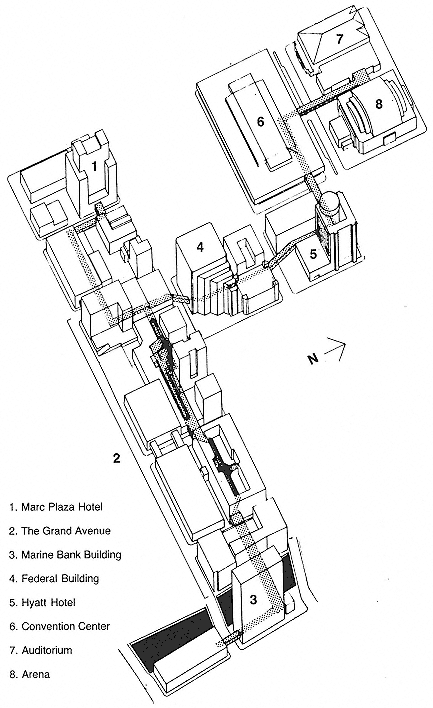
32.
The emerging skywalk system. All except the extension 0to the Marc Plaza Hotel has
been built.
Riverwalk
Bridging the Milwaukee River with a skywalk to East Town not only made a symbolic and practical connection but also gave impetus to a long-standing dream of turning the Milwaukee River into an urban amenity. Earlier, incidental, efforts to address the possibilities of the river now could be linked because of a real commitment, a belief in the value and the plausibility of a riverwalk system. Design specifications for it have been written.
Apart from serving as an amenity, a riverwalk will bridge a conceptual gap between commercial Milwaukee, as represented by Wisconsin Avenue businesses, and cultural Milwaukee, represented by the Performing Arts Center on the river several blocks to the north. A riverwalk system will link these and, more important, will provide support for another byproduct of downtown rejuvenation: a theater district.
Theater District
For several years the Milwaukee Repertory Theater had been searching for a space of its own, designed for its needs. Among its options was an unused power plant on the river halfway between Wisconsin Avenue and the Performing Arts Center. The lively new configuration of downtown represented in the Grand Avenue not only made the power plant location reasonable but also unleashed a slightly grander vision of a theater complex and activity node that would be a focus for the offerings of the Milwaukee Repertory Theater as well as those of the adjacent historic Pabst Theater and Performing Arts Center. The Grand Avenue thus gave the shot of confidence needed to spur investment in a mixed-use development associated with the theater district.[7] The focus of the new theater district is an arcadelike space supported economically by residential, office, and retail uses. Called Milwaukee Center, this node is conceived as a way of increasing and enhancing nightlife downtown, thus strengthening and supporting the Grand Avenue's shopping and service activities.
Extension of the Grand Avenue
The effects of the Grand Avenue are also being felt to the west. The Grand Avenue is expected to generate its own extension by enveloping an additional city block and by making an important skywalk connection to the Marc Plaza Hotel (shown in Figure 32).
West of Downtown
Further west, interest has been kindled in improving the connection between downtown and the area around Marquette University, now separated by the expressway. Discussions have been held and plans proposed to bridge this gulf. The Grand Avenue has proved that downtown can be attractive, thus giving impetus and reassurance to those who wish to upgrade this transitional area to the west.
Warehouse District
Even before the completion of the Grand Avenue, an area of underutilized loft buildings, warehouses, and produce markets to the south had been talked about as an asset to the city. Cer-
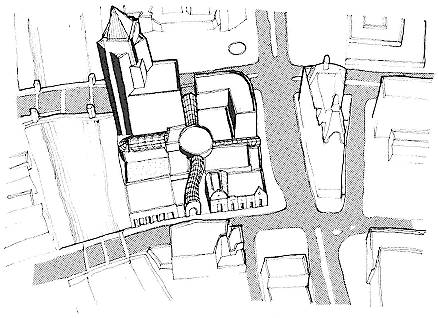
33.
Proposed Milwaukee Center, part of the new theater district
(City Hall to the right, Performing Arts Center above).
tainly, similar areas in other cities have been transformed and made economically viable. But until the Grand Avenue catalyzed a new "can-do" attitude, no real progress was made. The Third Ward warehouse district is now, however, experiencing a renaissance.
New Housing
Further afield, the impact of the Grand Avenue and related developments has inspired confidence that housing downtown will be desired if downtown itself is desirable. A townhouse development on the river has appeared, and land belonging to the Juneau Village urban renewal project that had remained vacant since the 1960s has become the site of middle- and upper-income housing. Called Yankee Hill, this project is a joint venture of the Milwaukee Redevelopment Corporation and a private developer, Madsen, the first to follow the Grand Avenue.
Brewery District
North of downtown, plans are under way to adapt for reuse two former breweries, one of which had been lying idle for years. An earlier concept for its adaptive reuse (Figure 123) was revised and implemented.
Although one way of characterizing the catalytic process in Milwaukee is to identify the physical increments of revitalization and transformation, the developments themselves, it is equally important to recognize the transformation in attitude that the Grand Avenue has engendered:
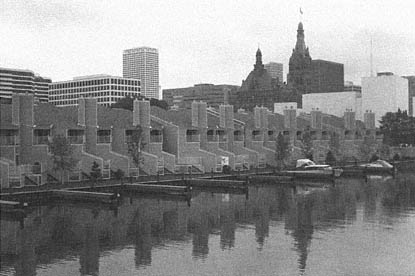
34.
New housing along the east bank of the Milwaukee River, designed by
William Wenzler Associates, architects (City Hall in background).
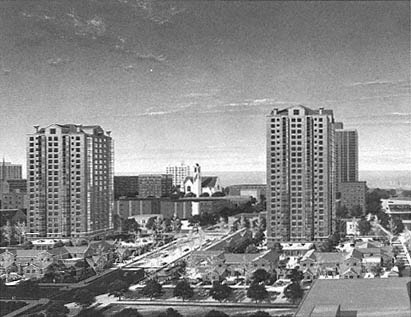
35.
Yankee Hill housing. Forty-four townhouses and two housing towers, designed
by Kahler Slater Torphy Engberg, architects. This joint venture by the Madsen
Corporation and the Milwaukee Redevelopment Corporation followed the MRC's
success with the Grand Avenue.
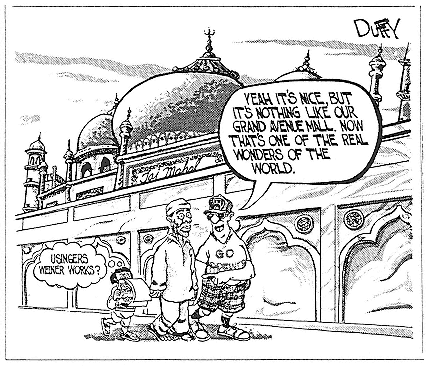
36.
Cartoon by Brian Duffy celebrating the Grand Avenue, published in
Milwaukee Magazine, November 1982.
I can't say that nothing would have happened downtown if the Grand Avenue hadn't happened—that's not true. But I don't know if people would have been as bullish about the redevelopment potential of the central city. I can tell you that the attitude in Milwaukee has changed from "The downtown is dead" to "Anything is possible and we can probably make it happen."[8]
According to John Wellhoefer, Dragos's successor at the MRC, "the success of the Grand Avenue meant a complete 180-degree turn in the sentiment about investing in Downtown Milwaukee. It used to be okay to work Downtown. Now it's a place people want to go to see and be seen."[9]
For Edmund Bacon, commenting on the transformation of downtown Milwaukee, "The real driving force of making a city become vibrant, alive and economically feasible rests in establishing in the collective mind of the people what the city can become."[10] The Grand Avenue and the chain reaction it has unleashed have created a situation in which "people want a renaissance of downtown to happen. . . . Today the general opinion is that downtown redevelopment should continue bigger and better, and that virtually anything is possible if we put our collective minds to it."[11]
All of the visions that accompany this flush of civic enthusiasm cannot be accommodated. Not everything can happen. What is important is that suddenly some dreams that had been thought unrealistic seem possible.